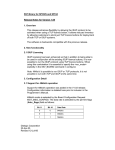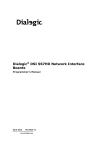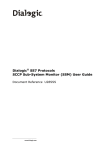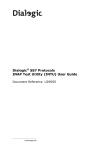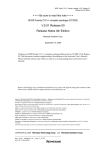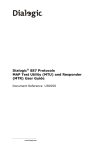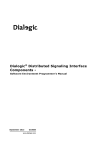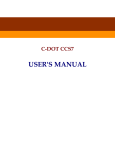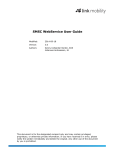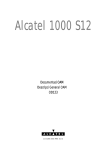Download Dialogic® DSI SS7HD Network Interface Board
Transcript
Dialogic® DSI SS7HD Network Interface Board - ss7.dc4 Code File - Release Notes Dialogic® DSI SS7HD Network Interface Board ss7.dc4 Code File Release Notes Document Reference: RN001DPK Publication Date: March 2012 Contents Release Notes for V5.12 ............................................................................................... 2 Release Notes for V5.11 ............................................................................................... 3 Release Notes for V5.10 ............................................................................................... 5 Release Notes for V5.09 ............................................................................................... 9 1 Dialogic® DSI SS7HD Network Interface Board - ss7.dc4 Code File - Release Notes Release Notes for V5.12 Release Notes for V5.12 1 Overview This release is a maintenance release which permits an alternative trace module to be configured for MTP2 tracing. The software is fully backwards compatible with the previous release. 1.1 Applicability This release is suitable for all users. 2 2.1 New Functionality MTP2 – Configurable trace_id The SS7HD board now supports MTP2 tracing to the alternative <trace_id> as specified using the TRACE_MOD_ID command in config.txt. Dialogic 02-Mar-12 2 Dialogic® DSI SS7HD Network Interface Board - ss7.dc4 Code File - Release Notes Release Notes for V5.11 Release Notes for V5.11 1 Overview This release is a maintenance release which provides an important MTP2 correction and provides updates to SCCP and TCAP protocols. The software is fully backwards compatible with the previous release. 1.1 Applicability This release is suitable for all users. In particular any installation using V5.09 or V5.10 software should be upgraded to this release. 1.2 Resolved Customer Issues Updates to resolve the following customer issues are included in this release: IPY00094434. 2 2.1 New Functionality SCCP – Support for 16 bit Point Codes This release adds the ability for SCCP to be configured to operate with 16 bit Point Codes as used in Japan. This mode of operation is selected by setting bit 15 of the ‘ext_options’ parameter in the SCCP Module Configuration message (SCP_MSG_CONFIG ) or setting bit 31 in the options field of the SCCP_CONFIG command in config.txt. When using 16 bit point codes, users should ensure that compatible options are selected for the MTP3 layers. 2.2 TCAP - Include TCAP Version in outgoing messages This release adds an option to force TCAP to include TCAP Protocol Version information in the messages it sends to SCCP. The TCAP Version information sent for ITU identifies Q.771-5 1997 (and 1993) specifications and for ANSI T1.114 1996. This option is enabled by setting bit 12 of the <options> parameter in the TCAP_MSG_CONFIG message or bit 12 of the ‘options’ field in the TCAP_CONFIG command in config.txt. 3 3.1 Other Changes MTP2 – Handling of long messages (IPY00094434) This release corrects a problem introduced in V5.09 software which could cause unpredictable behavior on receipt of MTP2 messages containing 253 or more octets in the SIF field. 3 Dialogic® DSI SS7HD Network Interface Board - ss7.dc4 Code File - Release Notes 3.2 Release Notes for V5.11 SCCP – Segmentation and Re-Assembly of XUDTS This release extends segmentation and re-assembly functionality to include XUDTS messages. For this release, SCCP handles segmentation and reassembly for XUDTS messages in the same manner as XUDT messages. 3.3 SCCP – RSP able to be ‘concerned’ about RSS SCCP has been enhanced to allow a Remote Signaling Point (RSP) to be configured as a concerned entity so that it receives notification of changes in status of a specified Remote Sub System (RSS). 3.4 SCCP –Connection ID allocation The method of allocating incoming Connection ID’s for Connection Oriented operation has been enhanced so Connection ID’s will cycle through the full range of values before reusing previous values. Dialogic 20-Sep-11 4 Dialogic® DSI SS7HD Network Interface Board - ss7.dc4 Code File - Release Notes Release Notes for V5.10 Release Notes for V5.10 1 Overview This release is a maintenance release which adds new capabilities to SCCP and TCAP and contains protocol updates for ISUP, TCAP and MAP as detailed below. The software is fully backwards compatible with the previous release. 1.1 Applicability This release is suitable for all users. 2 2.1 New Functionality SCCP - Ability to receive messages for any DPC This release adds the ability for local sub-systems to receive Connectionless SCCP messages irrespective of the DPC contained within the message. This is achieved by a run-time configuration option associated with the Local SubSystem (LSS) which allows received messages for any DPC not explicitly configured to be sent to that LSS. This functionality is enabled when configuring a LSS by setting bit 4 (SSRF_ANY_PC) in the ssr_flags parameter of the SCP_MSG_CNF_SSR (0x7741) message. When using config.txt this is achieved by setting bit 4 in the <flags> field of the SCCP_SSR command. 2.2 TCAP - Option to stop sent address being replaced by received address This release adds an option to force TCAP to always use the original Called Party Address throughout an outgoing dialogue rather than allowing it to be replaced by the address received in the first response received from the far end. To activate this feature, bit 11 of the <options> parameter in the TCAP_CONFIG command should be set to 1. 3 3.1 Other Changes ISUP – Circuit Group Measurements Prior to this release, the ISUP group measurement period was not being initialised to current time when a group is configured. As a consequence the measurement period for circuit groups which were dynamically added was set incorrectly. This has been corrected. 5 Dialogic® DSI SS7HD Network Interface Board - ss7.dc4 Code File - Release Notes 3.2 Release Notes for V5.10 TCAP - Overlength outgoing messages In the event that a message exceeds the maximum size for transmission to the network, TCAP will now discard the whole message and abort the dialogue. Previously in some situations just the dialogue portion was discarded resulting in a malformed message being sent to the network. 3.3 TCAP - Abort with User Abort Information When sending an ITU-T TCAP Abort message containing the User-AbortInformation parameter, any additional dialogue portion is discarded to ensure valid formatting of the outgoing message. 3.4 TCAP/MAP - ASN.1 non-minimum length encodings The TCAP specification Q.773 states that when ASN.1 encoding messages, length encodings should use as few as possible octets, e.g. encodings possible under X.209 such as 0x8174 and 0x820074 should both be sent as 0x74. Previously both the MAP and the TCAP modules would reject received network messages that did not conform to this rule. This release removes this restriction allowing receipt of messages from the network that use ASN.1 non-minimal length encoding. Outgoing messages are always encoded in accordance with the TCAP specification using the minimal length for ASN.1 lengths. 3.5 MAP - Maximum size of user UESBI data To align with the MAP specification, the maximum size of UESBI data has been reduced (from 128 to 16 octets). This affects the MAPPN_uesbi_iua and MAPPN_uesbi_iub parameters. 3.6 MAP – Additional error codes MAP now supports the following additional user error codes: MAPUE_unknown_MSC (3) MAPUE_no_handover_number_available (25) MAPUE_subsequent_handover_failure (26) MAPUE_forwarding_failed (47) 3.7 MAP - Missing mandatory parameters in user response data MAP now checks for missing mandatory parameters when the MAP-User enters response data. For previous releases it was only request data that was checked for missing mandatory parameters. The check now applies to both request and response primitive entry using the MAP_MSG_SRV_REQ message. Reporting of missing parameters is unchanged (from request checking): a MAPSWE_USER_MAND_MISSING error is reported in a MAP_MSG_ERROR_IND message and the number of the first mandatory parameter not found is given in the parameter data. 6 Dialogic® DSI SS7HD Network Interface Board - ss7.dc4 Code File - Release Notes 3.8 Release Notes for V5.10 MAP – Handling of segmented Result components In the event that reassembly of partial response data fails (for TCAP segmentation using TC-RESULT-NL and TC-RESULT-L messages), instead of simply discarding the previously stored data, MAP will abort the affected InvokeID. If abort occurs after a TC-RESULT-NL message, U-CANCEL is sent to TCAP, followed by MAP_CNF with a Provider error to the MAP-User and finally a UREJECT to TCAP. Aborts that occur after a TC-RESULT-L message will just send the MAP_CNF message with Provider error. The Abort may be caused by parameter format checks or exhaustion of the buffer space. Exhaustion of the buffer space is also reported using MAPSWE_TC_RESULT_NL_TOO_BIG. In addition this release modifies the processing of the SendParameters service so that response data received in multiple messages (one or more TCRESULT-NL messages followed by a TC-RESULT-L) is correctly handled. 3.9 MAP – Invalid user-supplied Invoke id in response If MAP receives an unknown Invoke ID in a response primitive in the MAP_MSG_SRV_REQ message, a software event report will now be generated. The event report uses the MAP_MSG_ERROR_IND message with error code MAPSWE_USER_INVOKE_ID_UNKNOWN (27) with the id field set to the UserDialogID and the first Diagnostic code set to the invalid InvokeID. MAP will also optionally generate a selective trace message with trace reason code MAPt_user_invoke_id_unknown (16). 3.10 MAP - Selective Tracing enabled by default Selective Tracing within MAP, as documented within the MAP Programmer’s Manual, is now enabled by default for all events. If required the MAP_MSG_S_SELTRACE_MASK message can be used to modify which events are selectively traced. 3.11 MAP - GPRS Node Indicator parameter support MAP services SendRoutingInfoForLCS and SubscriberLocationReport now support the GPRS Node Indicator parameter, MAPPN_gprs_node_ind (123). For further information refer to Dialogic® DSI SS7 Protocol Stack MAP Programmer's Manual U14SSS, Issue 14 3.12 MAP - Correction to Ellipsis parameter processing Unrecognised parameters in received MAP messages are stored in the MAP Ellipsis parameter (MAPPN_ellipsis). This release corrects a problem (for some services including CHECK_IMEI) that previously caused only the first unrecognised parameter to be stored. A potential problem with ellipsis parameter formatting has also been corrected. 7 Dialogic® DSI SS7HD Network Interface Board - ss7.dc4 Code File - Release Notes 3.13 Release Notes for V5.10 MAP - TC-REJECT component parameters passed to user On receipt of a valid TCAP REJECT component from the network, MAP now uses two new parameters to pass additional TCAP component data to the MAP user for diagnostic purposes. MAPPN_tcap_rej_problem_code (584) contains the Problem Code (0 to 7) of the REJECT component and MAPPN_tcap_rej_problem_type (585) contains the Problem Code tag that was used (0x80 to 0x83). The interpretation of the problem code value is dependent on the tag used. Reception of a valid REJECT component will cause a MAP-NOTICE-IND dialog message or a MAP-SERVICE-CNF message (with error parameter) to sent to the MAP-User. In both cases the two new parameters will now be returned in the messages. For the MAP-NOTICE-IND message, the existing parameter MAPPN_invoke_id (14) will now also be returned with the new parameters to identify the component referenced by the REJECT (MAPPN_invoke_id is already returned by the MAP-SERVICE-CNF message). 3.14 MAP - ASN.1 indefinite length termination octets returned in ellipsis data When MAP encounters unrecognised data in received messages, it is returned to the MAP-User in the Ellipsis parameter. In the previous releases where the unrecognised data has been encoded using ASN.1 indefinite length encoding, it is possible for length termination octets ‘EOC’ (two 0x00 octets) to be returned at the end of the Ellipsis parameter data. This release corrects the fault. Ellipsis parameter data will not be incorrectly terminated by indefinite length encoding termination octets. 3.15 MAP - Begin Subscriber Activity with single address For previous releases if the MAP-User specified only one of MAPPN_dest_ref (2) and MAPPN_orig_ref (4) parameters, sending of the BEGIN-SUBSCRIBERACTIVITY (BSA) service would be attempted and fail with MAPSWE_TX_FMT_ERR being reported. This has been corrected so that if only one of the parameters is present, it is ignored and the BSA component is not sent. 3.16 MAP - User and Provider Errors supported for all services MAP now allows the error parameters MAPPN_user_err (21) and MAPPN_prov_err (22) in all MAP services that return a response to the MAPUser. Dialogic 15-Jul-11 8 Dialogic® DSI SS7HD Network Interface Board - ss7.dc4 Code File - Release Notes Release Notes for V5.09 Release Notes for V5.09 1 Overview This release adds SNMP support and includes updates to protocol software for MTP, ISUP, SCCP, TCAP, MAP and IS41 as detailed below. The following User Documentation updates are available and should be consulted for further detail: • Dialogic® DSI Protocol Stacks MAP Programmer’s Manual, Issue 14. • Dialogic® DSI Protocol Stacks TCAP Programmer’s Manual, Issue 11. • Dialogic® DSI Protocol Stacks SNMP User Manual, Issue 2. The release is fully backwards compatible with the previous release. 1.1 Applicability This release is suitable for all users. 2 2.1 New Functionality MTP - SNMP Support This release includes SNMP support within MTP3 when used in conjunction with a Dialogic® DSI Development Package that supports SNMP. Refer to the Development Package release notes to determine whether this capability is supported. For details of SNMP configuration refer to the Dialogic® DSI Protocol Stacks SNMP User Manual, Issue 2. 2.2 MAP - New Services GetPassword/RegisterPassword The following MAP services have been added: • GetPassword for MAP Version 1 • RegisterPassword for MAP Version 1 For further information refer to MAP Programmer's Manual. 3 Other Changes 3.1 ISUP - Management Reset Operation of ISUP Circuit Group Supervision Management Reset requests has been enhanced to ensure that circuits are fully returned to the idle state irrespective of the operational state of the application. Previously the circuit was not returned to the idle state until a valid RLC had been received from the application for any circuits that had been carrying active calls prior to the reset. Whilst under normal operating conditions this 9 Dialogic® DSI SS7HD Network Interface Board - ss7.dc4 Code File - Release Notes Release Notes for V5.09 was fine it could lead to issues in situations where the reason for the management reset was that the application had crashed or had been restarted. Under such conditions the application would not have generated the RLC. The new mode of operation will ensure that in this scenario the restarted application can immediately start receiving calls. 3.2 ISUP - Circuit Group Statistics ISUP now gathers a number of call completion and circuit occupancy statistics on a per circuit group basis which can be read on-demand by the user and optionally reset. These statistics can be assessed using the following ISUP message: MESSAGE HEADER Field Name Meaning type ISP_MSG_R_GRP_STATS (0x6719) id GID src Sending module_id dst ISP_TASK_ID rsp_req Sending layer’s bit must be set hclass 0 status Set to 1 to reset the measurements or 0 to leave measurements unmodified err_info 0 len 32 PARAMETER AREA 3.3 Offset Size Name 0 1 version – must be set to zero. 1 3 Reserved 4 4 period – The measurement period. 8 4 ic_attempt – Incoming call attempts 12 4 og_attempt – Outgoing call attempts 16 4 ic_answered – Incoming calls answered 20 4 og_answered – Outgoing calls answered 24 4 duration – Total accumulated call duration for completed calls in the group 28 4 max_device – Maximum number of devices busy at one time ISUP - 8-bit SLS in ANSI Networks Selection of 8 bit SLS values is achieved using a new per circuit group option, ISPX1GOP_SLS8 (bit 22, 0x00400000), in the ext_1_options field of the ISP_MSG_CNF_GRP message. This is bit 22 of the <options2> parameter in the ISUP_CFG_CCTGRP command in config.txt. 10 Dialogic® DSI SS7HD Network Interface Board - ss7.dc4 Code File - Release Notes Release Notes for V5.09 When ISUP has been configured for 24 bit point codes and the ISPX1GOP_SLS8 option has been set ISUP will set the SLS to the 8 least significant bits of the CIC otherwise it will set the SLS to 5 bits. 3.4 ISUP - Application Heartbeat for BICC Prior to this release, when the ISUP heartbeat timer expired ISUP would send a hardware-blocking message to the remote signaling point for each affected circuit group. As BICC does not support hardware-blocking the functionality has been modified such that on heartbeat timer expiry for BICC circuit groups will send a circuit group reset message followed by maintenance-blocking message. 3.5 TCAP - Configurable trace module id A Trace Module ID can now be defined in the TCAP Module Configuration message (TCP_MSG_CONFIG). The new ‘trace_id’ field uses a previously reserved field in the message. If trace_id is defined as non-zero, the all trace messages are sent to that module id. If trace_id is set to zero, trace messages are sent to the Management Module ID (mngt_id) as for previous releases. For further information refer to TCAP Programmer's Manual. 3.6 MAP - Formatting of TCAP response messages For previous releases the TCAP formatting of the response messages for some services could be incorrect. This fault affected response messages where only an Invoke ID parameter was defined (no other parameters). This caused an invalidly formatted response message to be sent to TCAP. The following services were affected: AuthenticationFailureReport SetReportingState StatusReport Register-CC-Entry SendEndSignalling PrepareHandover SendAuthInfo (for MAP V3) The fault has been corrected for this release and the response messages are correctly formatted when sent to TCAP. 3.7 MAP - QoS Transparency The MAP module can be configured to return any QoS information received from TCAP to the MAP-User. This is controlled via a new configuration option flag, MAPF_QOS_TRANSPARENT. The option is applicable to the MAP_MSG_CONFIG and MAP_MSG_NC_CONFIG configuration messages, e.g. this facility is selectable for different MAP-Users via the Module and NC configurations. When the option is enable, whenever QoS data is received from TCAP it will be returned to the MAP_User in the next Dialogue Indication message. For further information refer to MAP Programmer's Manual. 11 Dialogic® DSI SS7HD Network Interface Board - ss7.dc4 Code File - Release Notes 3.8 Release Notes for V5.09 MAP - Message generation after MAP-NOTICE-IND and/or TC-U-REJECT For previous releases, MAP was not correctly handling some situations that required MAP-NOTICE-IND messages to be sent to the user and/or U-REJECT to be sent to TCAP and the dialog was left in an inappropriate state. MAP should either close the dialog and send a MAP-CLOSE-IND message or move to a next state and send the user a MAP-DELIMITER-IND message. This release ensures that it is correctly handled. In order to prevent unexpected behaviour in some MAP applications this change can be disabled using a MAP configuration option. It is recommended that this option should only be set to 1 when the messages now being generated cause problems for the MAP application. Otherwise the flag should be set to 0. For further information refer to MAP Programmer's Manual. Dialogic 01-Jul-10 12












